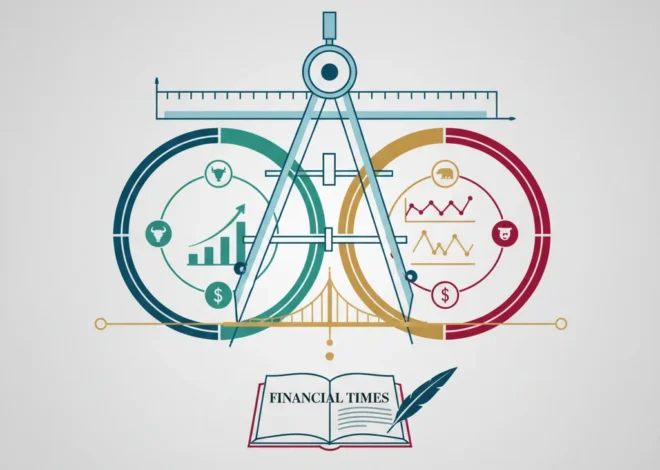
Financial Shockwaves: Why US Banking Jitters Are Rocking the UK Stock Market
The world of global finance is a deeply interconnected ecosystem. A tremor in one market can quickly become an earthquake in another, thousands of miles away. We saw this principle in sharp relief recently as troubling news from the United States’ regional banking sector sent a wave of anxiety across the Atlantic, directly impacting the UK stock market. What began as a localized issue with a couple of American banks spiraled into a global concern, prompting investors in London to hit the sell button and ask a critical question: how exposed are we?
This blog post will dissect the recent market turmoil, exploring the root causes of the US banking instability, why it triggered such a significant sell-off in UK shares, and what this means for investors, business leaders, and the broader economy. We’ll move beyond the headlines to understand the underlying mechanics of financial contagion and offer an expert perspective on navigating this volatile landscape.
The Catalyst: Unpacking the Crisis in US Regional Banking
To understand the reaction in London, we must first look to the source of the problem in the United States. The recent turmoil wasn’t caused by the global banking giants we all know, but by regional banks—institutions that serve specific geographic areas or niche industries. The issues stemmed from a potent cocktail of aggressive interest rate hikes by the Federal Reserve and specific risk management failures within the banks themselves.
As the Fed raised rates to combat inflation, the value of older, lower-interest government bonds held by these banks plummeted. This created massive “unrealized losses” on their balance sheets. For a bank like Silicon Valley Bank (SVB), which had a concentrated, tech-focused depositor base, a sudden wave of withdrawals forced it to sell these bonds at a huge loss, revealing its insolvency and triggering a classic bank run. The subsequent failure of other institutions like Signature Bank only amplified the panic.
This series of events exposed a critical vulnerability in a segment of the US banking system, leading to a crisis of confidence. Investors globally began to worry that this wasn’t an isolated incident but a symptom of a wider, systemic problem within the financial sector. This fear is precisely what traveled across the ocean, as problems at these US regional banks made international investors incredibly nervous and triggered a broad sell-off in shares (source).
Beyond Payouts: Why the Insurance Industry Is Pivoting to Climate Consulting
The Ripple Effect: How US Fears Drove a UK Sell-Off
When confidence in the banking sector wanes, the reaction is swift and often indiscriminate. News of the US bank failures sent a chill through the global stock market, and London’s FTSE 100 was no exception. The primary driver of this sell-off was not necessarily a belief that UK banks faced the exact same issues, but rather a classic “risk-off” sentiment—a flight to safety where investors dump assets perceived as risky (like equities) in favor of safer havens (like government bonds or gold).
UK banking stocks bore the brunt of the sell-off. Investors, spooked by the speed of the US collapses, began scrutinizing the balance sheets of all banks, looking for any signs of similar vulnerabilities. Even though major UK banks are generally better capitalized and more diversified than the failed US regional banks, fear trumped fundamental analysis in the short term. The logic is simple: in a panic, you sell first and ask questions later. This widespread nervousness was the direct cause of the market downturn, a clear sign of how interconnected modern global finance has become.
Below is a look at how some of the UK’s major financial institutions were impacted during the initial wave of selling pressure, reflecting the market’s broad-based anxiety.
| UK Financial Institution | Illustrative Peak-to-Trough Share Price Drop (During Initial Sell-Off) | Key Investor Concern |
|---|---|---|
| Barclays PLC | Approximately -12% | General exposure to global financial markets and investment banking activities. |
| Lloyds Banking Group | Approximately -10% | Sensitivity to the UK domestic economy and potential for a credit crunch. |
| NatWest Group | Approximately -9% | Concerns over broader economic slowdown impacting lending and credit quality. |
| HSBC Holdings PLC | Approximately -7% | Global systemic risk and exposure to international markets beyond just the UK. |
This data illustrates that no major bank was immune. The sell-off was less about the individual health of these specific UK institutions and more about the overarching fear of financial contagion, a powerful force in the world of economics and trading (as reported by the BBC).
The Deeper Story: Interest Rates, Inflation, and Modern Finance
The banking jitters are a symptom of a much larger economic story. For over a decade, the world operated in a near-zero interest rate environment. This encouraged risk-taking and flooded the system with cheap money. Now, central banks, including the Bank of England and the US Federal Reserve, have been forced to hike rates at a historic pace to tame runaway inflation.
This rapid shift has consequences. It puts immense pressure on bond portfolios, as we saw with the US regional banks. It also increases borrowing costs for businesses and households, raising the risk of loan defaults. Furthermore, it changes the entire calculus of investing, making lower-risk assets that offer a decent yield more attractive relative to stocks.
The role of financial technology, or fintech, also plays a part. The same technology that allows for seamless mobile banking also enabled the lightning-fast bank run on SVB. Depositors could withdraw billions with a few taps on their smartphones, a scenario unimaginable in previous eras. While fintech and blockchain technologies offer incredible efficiency, they also accelerate the speed at which a crisis of confidence can unfold, presenting a new challenge for regulators and the banking industry.
The Ultimate ESG Test: When Nature Has a Seat at the Trading Desk
Navigating the Aftermath: What This Means for You
For investors, this period of volatility is a crucial test of discipline and strategy. The immediate sell-off was driven by fear, but long-term success in investing is built on rational analysis. It’s an opportunity to reassess portfolio diversification and risk tolerance. Are you overly concentrated in one sector, particularly a cyclical one like banking? This event underscores the timeless wisdom of not putting all your eggs in one basket.
For business leaders, the key takeaway is the potential for tightening credit conditions. When banks become nervous, they tend to pull back on lending to preserve capital. This can make it harder and more expensive for companies to secure financing for expansion, operations, or investment. Proactively managing cash flow and securing credit lines before they are urgently needed is a prudent strategy in the current economic climate.
Ultimately, the UK stock market’s reaction to problems at a few US regional banks was a stark reminder of our globalized economy (source). It highlights how investor sentiment can be as powerful a market-mover as any financial report. While the direct exposure of UK banks to the specific issues that felled their US counterparts appears limited, the indirect exposure to a global confidence crisis is very real. Watching the response of central banks and regulators in the coming months will be critical to understanding whether this was a contained squall or the start of a much bigger storm.
The Great Wall at 0K: Is Bitcoin's Institutional Rally Hitting a Ceiling?
In conclusion, the nerves that rippled through the UK stock market were a rational response to a genuine, albeit distant, threat. It demonstrated the fragility of confidence in our complex financial system and the profound impact of macroeconomic forces on every corner of the market. For those engaged in finance, investing, and business, it serves as a powerful lesson in risk management and the enduring importance of looking beyond domestic headlines to understand the global forces shaping our economic destiny.


